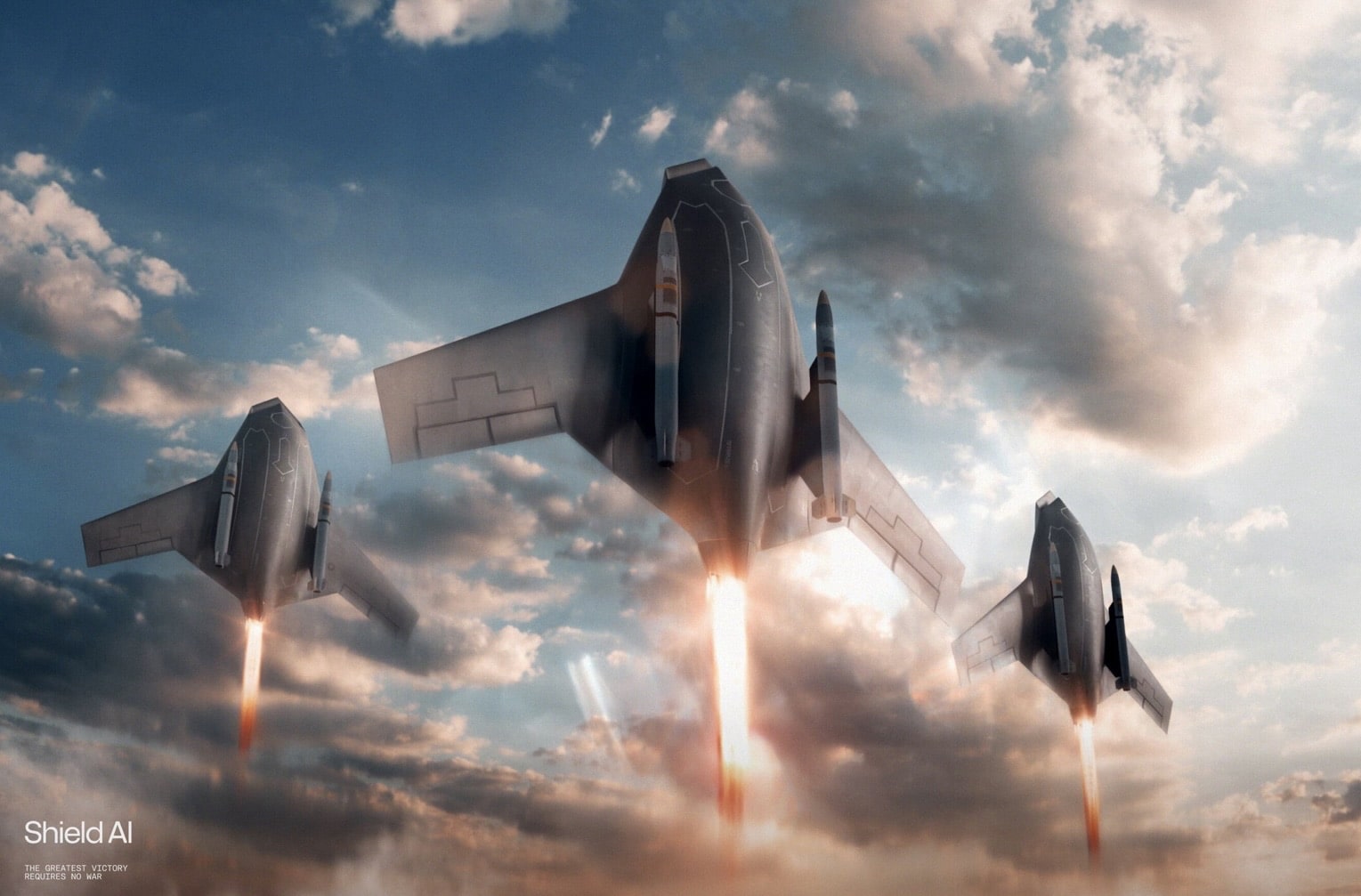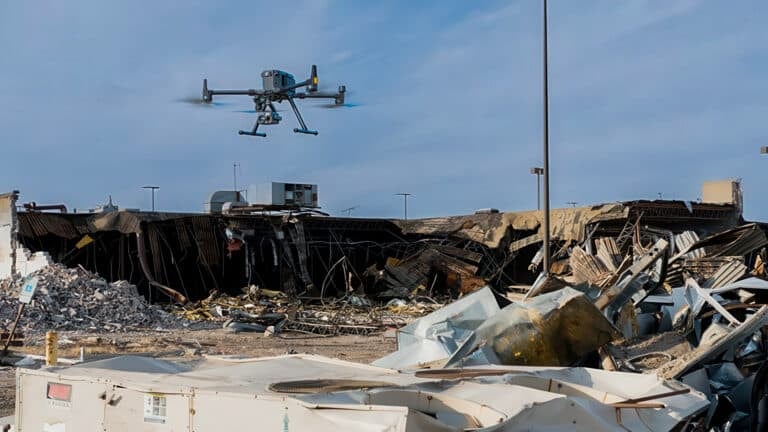Shield AI’s X-BAT: SpaceX-Style Vertical Landing Meets Combat-Proven AI in $27M Fighter Drone

A jet-powered drone that launches vertically like a rocket, flies over 2,000 miles autonomously without GPS, and lands tail-first on a trailer could reshape air warfare—and it’s built by engineers who perfected SpaceX’s reusable rocket landings.
Shield AI unveiled the X-BAT on October 21, 2025 in Washington, D.C., revealing a vertical takeoff and landing (VTOL) autonomous fighter that combines stealth design, extended range, and the company’s battle-tested Hivemind AI software. At roughly $27 million per unit, the X-BAT costs a quarter of an F-35 while promising to operate from ships, remote islands, or anywhere a trailer can reach—no runway required.
The aircraft represents a pivotal moment in military aviation. Unlike traditional fighters dependent on vulnerable airfields, the X-BAT launches straight up using a single afterburning jet engine, transitions to horizontal flight, completes its mission autonomously, then returns to land vertically on its launch platform. Think SpaceX’s Falcon 9 rocket landings, but weaponized.
From Starship to Warship: The SpaceX Connection
The comparison to SpaceX isn’t coincidental. Leading Shield AI’s X-BAT development is Armor Harris, who spent years at SpaceX as the responsible engineer for Falcon 9’s propulsive landing capability—the breakthrough that enables those dramatic rocket recoveries. Harris also served as head engineer for the Starlink satellite constellation and senior director of Starshield, SpaceX’s government-focused division.
“VTOL plus range solves survivability on the ground and dependency on tankers,” Harris told reporters at the unveiling. “Multirole provides critical flexibility as the threat evolves, because no plan survives first contact with the enemy.”
The 32-year-old engineer brought SpaceX’s rapid iteration culture to Shield AI when he joined in March 2024. His team moved X-BAT from concept to flying test article in just 18 months—a development timeline that would be unthinkable at traditional defense contractors.
Before joining Shield AI, Harris helped deliver Starlink to Ukraine as it fought the Russian invasion in 2022, giving him firsthand exposure to how satellite internet and autonomous systems perform under the most contested electromagnetic conditions on Earth.

Technical Specifications: Fighter Performance, Drone Efficiency
The X-BAT packs impressive specifications into a surprisingly compact airframe. At 26 feet long with a 39-foot cranked-delta wingspan, it’s roughly half the size of an F-35. Shield AI specifications reveal:
- Range: 2,000+ nautical miles (3,700+ km)
- Altitude: 50,000+ feet (15,240+ m) service ceiling
- Speed: Supersonic capable (potentially Mach 1.2 with afterburner)
- Engine: GE F110-GE-129—the same proven powerplant flying in F-15 and F-16 fighters
- Payload: Internal weapons bay for stealth operations, plus external hardpoints for air-to-air, air-to-surface, and electronic warfare missions
- Footprint: Three X-BATs occupy the same deck space as one conventional fighter
The aircraft’s partnership with GE Aerospace, announced November 5, 2025, pairs the F110-GE-129 engine with an advanced Axisymmetric Vectoring Exhaust Nozzle (AVEN) for thrust vectoring—essential for the vertical launch and landing maneuvers.
Battle-Tested AI: From Ukraine to X-BAT
What sets X-BAT apart from concept drones isn’t just its VTOL capability—it’s the combat-proven artificial intelligence piloting it. Shield AI’s Hivemind autonomy software already flies the company’s smaller V-BAT reconnaissance drone, which has logged over 130 sorties in Ukraine since June 2024.
The V-BAT’s performance in Ukraine validated Hivemind’s core capability: operating effectively when GPS is jammed and communications are severed. Ukrainian forces successfully used V-BAT to locate a Russian SA-11 Buk-M1 mobile air defense system despite pervasive electronic warfare. Ukrainian forces subsequently destroyed the target using HIMARS precision rockets.
“In Ukraine, V-BAT demonstrated resilience against electronic warfare, showcasing autonomy in the toughest conditions and completing the first successful long-endurance, long-duration ISR and targeting mission while GPS and comms were jammed,” Shield AI stated in its year-end summary.
James Lythgoe, Shield AI’s Ukraine managing director and former UK Royal Marine, put it bluntly:
“V-BAT, powered by our Hivemind autonomy stack, remains the only long-endurance ISR and strike platform to penetrate both Ukrainian and Russian GPS and comms jammers.”
That battlefield-hardened AI now scales to X-BAT, enabling autonomous penetration of contested airspace, dynamic teaming with manned aircraft, and collaborative tactics without constant communications.
Development Timeline and Production Plans
Shield AI has been aggressive with its timeline. The company began X-BAT development in spring 2024 and unveiled the program 18 months later with significant test progress already completed.
The development roadmap includes:
- Fall 2026: Initial vertical takeoff and landing demonstrations
- 2027-2028: Full flight testing and operational validation
- 2028: Mission capability target
- 2029+: Production ramp-up
While Shield AI designed the X-BAT, the company acknowledged it will partner with established aerospace manufacturers for production. Harris indicated those partnerships would be announced in coming weeks. The GE Aerospace engine partnership represents the first major collaboration disclosed.
Pricing remains strategic. At approximately $27 million per unit, X-BAT undercuts traditional fighters by an order of magnitude while delivering comparable capabilities. Former Air Force Secretary Frank Kendall previously estimated that Collaborative Combat Aircraft should cost roughly one-third the price of crewed fighters—putting X-BAT squarely in that target range.
Strategic Implications: The Runway Independence Revolution
The tactical advantages of vertical launch capability extend far beyond novelty. In any peer conflict, enemy forces will target runways immediately. China’s DF-21 and DF-26 anti-ship ballistic missiles are purpose-built to crater airfields and eliminate aircraft on the ground. Russia demonstrated this doctrine by repeatedly targeting Ukrainian airbases throughout the current conflict.
X-BAT eliminates that vulnerability entirely. The aircraft launches from a mobile trailer that can be transported by truck, deployed on ships, positioned on remote islands, or hidden in austere forward operating bases. No concrete runways. No extensive ground infrastructure. No predictable targets for enemy missiles.
Brandon Tseng, Shield AI’s president and co-founder (and former Navy SEAL), captured the strategic significance at the unveiling:
“Airpower without runways is the holy grail of deterrence. It gives our forces persistence, reach, and survivability, and it buys diplomacy another day.”
The force multiplication factor is equally compelling. Three X-BATs fit in the deck space of one conventional fighter aircraft, tripling sortie generation rates from the same footprint. On aircraft carriers with limited deck space, that ratio transforms operational capacity.
The cost differential amplifies this advantage. For the price of four F-35s ($400+ million), a military could field approximately 15 X-BATs—distributing capability across more platforms, making the force more resilient to losses, and creating targeting dilemmas for adversaries.
Market Context: Collaborative Combat Aircraft Competition
Shield AI enters an increasingly crowded field of companies developing autonomous wingman drones. The U.S. Air Force’s Collaborative Combat Aircraft (CCA) program has already selected General Atomics and Anduril for Increment 1, with both companies now conducting flight tests.
Lockheed Martin recently unveiled its “Vectis” concept. Northrop Grumman remains active in the space. Boeing, Kratos, and other traditional defense firms all have competing designs.
What differentiates X-BAT in this competition is the combination of four attributes that Harris emphasized: “VTOL, range, multirole capability, and autonomy.” No other platform currently combines all four.
The Navy has taken particular interest. The UK’s Royal Navy issued a Request for Information in October 2025 for Project VANQUISH—a technical demonstration of an autonomous drone capable of sea-based takeoff and landing, with completion expected by end of 2026. X-BAT appears purpose-built for such requirements.
The Air Force’s CCA program remains fluid, with requirements for future increments still undefined. Air Force Secretary Troy Meink recently indicated preference for lower-cost CCAs than initially planned, which could favor more affordable platforms like X-BAT over increasingly exquisite designs from traditional contractors.
DroneXL’s Take
Shield AI’s X-BAT represents the convergence of three trends DroneXL has tracked extensively: Ukraine’s validation of autonomous drone warfare, Silicon Valley engineering culture disrupting traditional defense contractors, and the escalating importance of runway-independent operations.
The Ukraine connection deserves emphasis. While defense startups routinely claim revolutionary capabilities, Shield AI brings receipts. The company’s V-BAT reconnaissance drones have flown over 130 combat sorties in the world’s most electromagnetically contested battlefield, successfully operating when GPS and communications were completely jammed. That’s not PowerPoint warfare—it’s proven performance against peer-level electronic warfare that has disabled numerous Western systems.
We’ve documented Ukraine deploying 9,000 drones daily, establishing the world’s first Unmanned Systems Forces, and demonstrating that cheap, mass-produced autonomous systems can outperform expensive traditional platforms. The lesson has been clear: affordable autonomy at scale beats small numbers of exquisite crewed systems in modern warfare.
X-BAT takes that doctrine and scales it to fighter-class aircraft. At $27 million versus $100+ million for an F-35, the cost curve finally enables the “affordable mass” concept Pentagon strategists discuss but traditional contractors can’t deliver. Three X-BATs in the space of one conventional fighter fundamentally changes force structure calculus.
The SpaceX connection matters beyond just vertical landing technology. Armor Harris brings a development culture that shipped over 1,800 Starlink satellites in 18 months—moving at a pace unthinkable in traditional aerospace. That same culture moved X-BAT from concept to flying demonstrator in the same timeframe. If Shield AI can maintain anything approaching that velocity through production, it will force traditional prime contractors to fundamentally rethink how they develop and field systems.
The geopolitical timing is critical. China fields the world’s largest navy and controls the first island chain with land-based missiles that can target any runway within 1,000 miles. Traditional carrier-based aviation faces existential targeting challenges. X-BAT’s ability to launch from small deck ships, expeditionary islands, or mobile trailers scattered across the Pacific directly counters China’s anti-access strategy. It’s the right capability for the most likely future conflict.
Questions remain. Can Shield AI actually deliver on its 2028 timeline? Will the AI autonomy truly perform as advertised in combat conditions more complex than ISR missions? Can the company secure the production partnerships and scale manufacturing to achieve meaningful unit volumes? And will U.S. military buyers embrace a startup’s platform over traditional contractors with established relationships?
But here’s what we know: Ukraine has already proven that drone warfare dominates modern battlefields. The country produces 200,000 drones monthly and has validated autonomous operations in the most challenging conditions. X-BAT represents the logical evolution—taking those lessons learned and applying them to fighter-class aircraft that don’t need runways, can operate autonomously when communications fail, and cost a fraction of legacy platforms.
Whether X-BAT succeeds commercially or not, the concept it represents—autonomous, runway-independent, affordable mass—will define air combat in the coming decades. Traditional defense contractors are watching. So is China.
What do you think? Share your thoughts in the comments below.
Photo courtesy of Shield AI
Discover more from DroneXL.co
Subscribe to get the latest posts sent to your email.
Check out our Classic Line of T-Shirts, Polos, Hoodies and more in our new store today!

MAKE YOUR VOICE HEARD
Proposed legislation threatens your ability to use drones for fun, work, and safety. The Drone Advocacy Alliance is fighting to ensure your voice is heard in these critical policy discussions.Join us and tell your elected officials to protect your right to fly.
Get your Part 107 Certificate
Pass the Part 107 test and take to the skies with the Pilot Institute. We have helped thousands of people become airplane and commercial drone pilots. Our courses are designed by industry experts to help you pass FAA tests and achieve your dreams.

Copyright © DroneXL.co 2025. All rights reserved. The content, images, and intellectual property on this website are protected by copyright law. Reproduction or distribution of any material without prior written permission from DroneXL.co is strictly prohibited. For permissions and inquiries, please contact us first. DroneXL.co is a proud partner of the Drone Advocacy Alliance. Be sure to check out DroneXL's sister site, EVXL.co, for all the latest news on electric vehicles.
FTC: DroneXL.co is an Amazon Associate and uses affiliate links that can generate income from qualifying purchases. We do not sell, share, rent out, or spam your email.


















